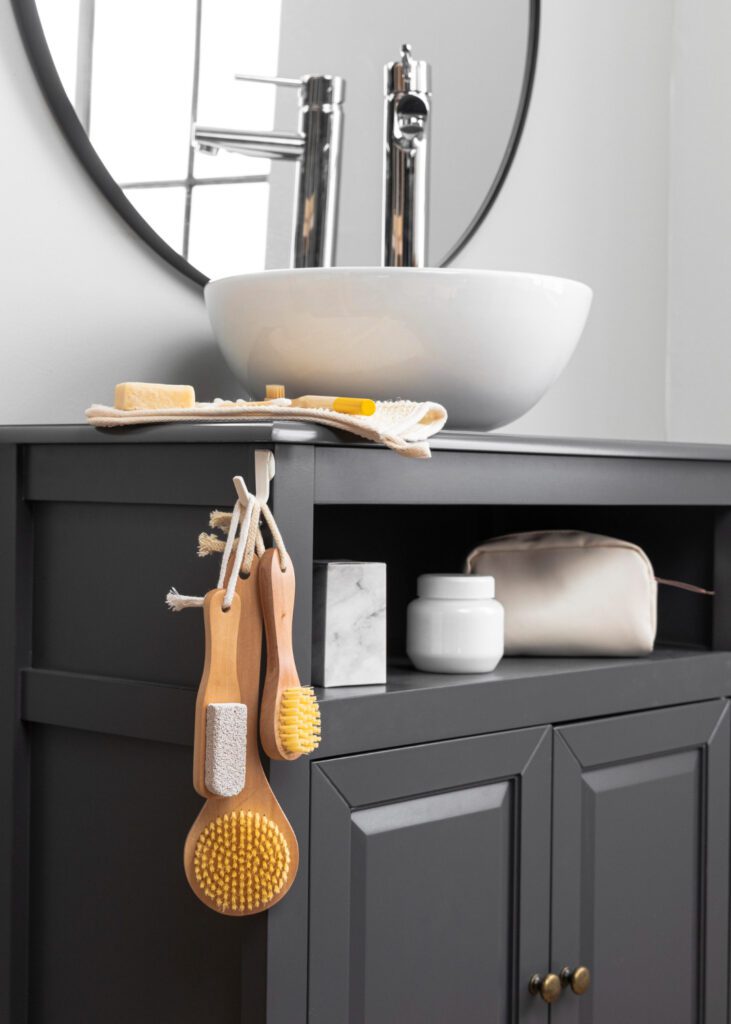The bathroom is no longer just a functional space for daily routines. Increasingly, it has become a personal retreat where comfort, relaxation, and aesthetic appeal matter just as much as utility. Considering we spend over an hour on average in the bathroom every day, designing this space thoughtfully has never been more important. Every inch counts, and choosing the right furniture can make a substantial difference in both organization and overall ambiance. One of the most effective ways to enhance your bathroom’s functionality and style is by selecting the right freestanding bathroom cabinet. But with so many options available, how do you choose a cabinet that is both practical and visually appealing?
Durability and moisture resistance matter most
Bathrooms are among the most humid areas of a home, making moisture resistance a critical factor when selecting a cabinet. Opting for materials specifically designed to withstand damp conditions ensures longevity and maintains the cabinet’s appearance. High-quality options include moisture-resistant MDF, laminated surfaces, or lacquered wood. These materials maintain their shape and finish even in consistently humid environments. According to Dr. Susan Miller, a materials expert from the University of Cambridge, “Selecting moisture-resistant materials can increase the lifespan of bathroom furniture by up to 50%.”
Plastic cabinets are completely water-resistant and lightweight, making them a viable option for smaller bathrooms or areas prone to water splashes. However, they are often criticized for appearing cheap or less stylish. Stainless steel cabinets are excellent for modern interiors, but only if they are treated to resist corrosion. Untreated metal will quickly develop rust, diminishing both appearance and durability.
Avoid cabinets made from untreated wood or basic particle boards. These materials are prone to warping, swelling, and discoloration when exposed to moisture, rendering them impractical over time. Likewise, extremely thin laminates may not provide adequate protection against humidity, even if they initially appear attractive.
Finding the right size for your bathroom
Once you have selected a durable material, the next consideration is the cabinet’s size. Many bathrooms are compact, so it is essential that the furniture does not obstruct movement or feel cramped. Before purchasing, carefully measure the intended space, considering door swings and drawer access. A cabinet that is too large can make the room feel cluttered, while one that is too small may not provide the storage you need.
Think about the items you intend to store. Cabinets with adjustable shelves, drawers of varying sizes, or a mix of open and closed storage areas allow you to organize personal care items, towels, and cleaning products efficiently. A well-planned cabinet ensures that everything you need is easily accessible, contributing to a tidy and stress-free bathroom environment.
Choosing a design that complements your interior
While functionality is crucial, the cabinet’s appearance significantly impacts the overall look of your bathroom. A freestanding cabinet can serve as a striking focal point, so it should harmonize with your chosen style. For modern bathrooms, cabinets with clean lines, muted tones, and matte finishes work best. Scandinavian or classic interiors often benefit from light, neutral colors that evoke a sense of warmth and cleanliness.
When selecting a design, consider coordination with other bathroom elements such as mirrors, faucets, and shower enclosures. A thoughtfully matched cabinet not only enhances the room’s aesthetics but also contributes to a cohesive, polished appearance. European interior designer Marta Lindholm emphasizes, “A bathroom cabinet is not just storage; it is a design statement that can define the entire space.”
Practical features to improve daily convenience
Modern freestanding bathroom cabinets often include thoughtful features that make everyday use more convenient. Soft-close drawers and doors reduce noise and minimize wear over time, while integrated compartments, pull-out shelves, or hidden laundry baskets help maximize storage in limited spaces. Features like these transform a simple cabinet into a versatile, efficient organizational solution. Dr. James Robertson, a home ergonomics specialist from the University of California, notes, “Small functional details in cabinetry can significantly improve daily routines, reducing stress and clutter.”
Some cabinets also offer specialized compartments for toiletries, cleaning supplies, or small appliances, allowing users to maintain a clutter-free surface. Investing in a cabinet with these functional details improves usability and enhances the overall sense of order in the bathroom. Here are practical tips to consider when choosing a cabinet:
- Check for soft-close mechanisms on drawers and doors to reduce noise.
- Look for pull-out shelves or hidden compartments for better organization.
- Evaluate if the cabinet has integrated laundry or waste baskets for convenience.
- Ensure compartments are adjustable to store items of varying sizes.
- Confirm the cabinet’s weight capacity aligns with your storage needs.
Avoidable mistakes when selecting a bathroom cabinet
To make the most of your investment, it’s important to avoid common pitfalls. Selecting a cabinet solely based on appearance, without considering size, material, or practical features, can lead to frustration and unnecessary costs. Buying a model that is too large or too small for your space, or one made from inappropriate materials, will compromise both usability and durability.
Another frequent mistake is neglecting the cabinet’s coordination with the rest of the bathroom. Even a beautiful cabinet can look out of place if it clashes with the room’s overall design, diminishing the sense of harmony and comfort. Taking the time to evaluate the cabinet’s material, dimensions, style, and functionality ensures a solution that enhances both convenience and aesthetics.
Making a confident choice
Selecting a freestanding bathroom cabinet is more than a practical decision—it is an opportunity to elevate the style and efficiency of your bathroom. By focusing on moisture resistance, size, design, and functional features, you can find a cabinet that perfectly balances aesthetics and utility. Careful planning and attention to detail will allow you to create a space that is both visually pleasing and exceptionally organized, turning your bathroom into a haven for relaxation and daily comfort. An interview with American interior designer Laura Bennett highlights, “The right cabinet can transform a mundane bathroom into a serene retreat, blending function and style seamlessly.”
Summary:
- Moisture resistance is crucial: Choose materials like treated MDF, laminated surfaces, or lacquered wood. Avoid untreated wood or thin laminates.
- Right size matters: Ensure the cabinet fits comfortably in your bathroom and meets your storage needs.
- Design and style: Match the cabinet with your bathroom’s aesthetic to create a cohesive and attractive interior.
- Functional features: Soft-close doors, pull-out shelves, and hidden compartments increase convenience and organization.
- Avoid common mistakes: Don’t compromise on materials or size, and ensure the cabinet complements the overall interior.
With these practical insights, choosing a freestanding bathroom cabinet becomes a straightforward and rewarding process, ensuring that your bathroom is both stylish and highly functional. European design consultant Henrik Svensson adds, “Investing time in selecting the right cabinet pays off daily, as it enhances comfort, organization, and the overall look of your home.”









